The offseason deep dives continue with the Irish passing offense, a unit that also struggled with consistency with Drew Pyne starting ten games. The passing game sometimes feasted on overmatched defenses (UNC, BYU, USC), but more commonly struggled with defenses whether opponents were similarly talented or overmatched.
Defensive coordinators often dared Pyne and the Irish wide receivers to beat them, and the results were mixed, even within the same game (Hello, Navy!). As mentioned in the rushing breakdown, the rushing attack was often asked to shoulder the offensive burden with the passing game used sparingly as a complementary or emergency piece in wins like Syracuse or Clemson.
Previous entries:
The ’22 numbers hide reliability and consistency issues with Pyne
What if I told you that the 2022 Notre Dame passing offense was nearly identical statistically to Ian Book’s final season in 2020? Or at roughly the same level as the Jack Coan-led attack in 2021? The full season numbers paint a picture that doesn’t match the eye test, and the game-to-game inconsistency is a massive reason why.
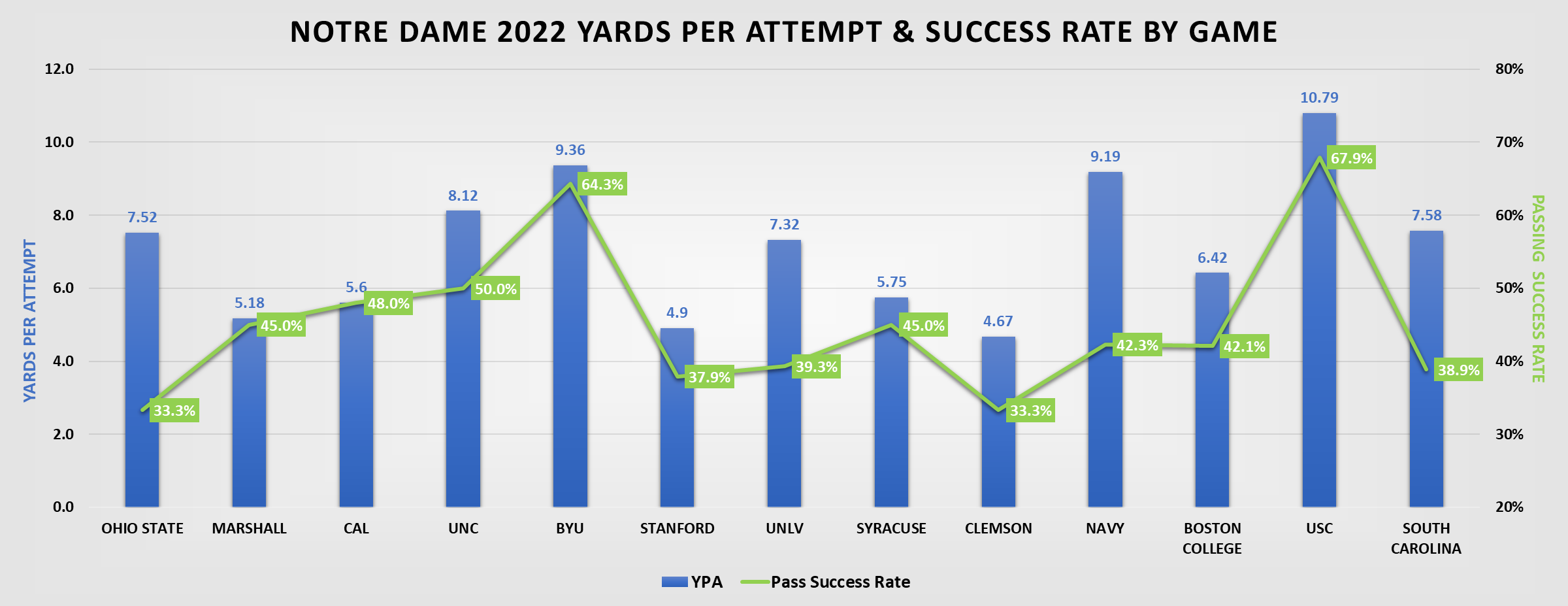
Drew Pyne’s great passing performances – mostly against ghastly defenses like UNC, BYU, and USC – were phenomenal. In those outings Pyne built up a stash of explosive and efficient performances like he was trying to win the Heisman in NCAA Dynasty mode. Unfortunately he couldn’t unearth the same types of performances against other defenses on the schedule, including strong and weak passing units from Cal to Stanford to Clemson and Syracuse.
Tommy Rees’ conservative approach further helps mask the up-and-down nature of the passing game under Pyne. He attempted more than 30 pass attempts just once, at UNC. In the six game stretch from Stanford to BC, Pyne’s average stat line was 12.5 completions on 24.5 attempts for 164 yards. So he accumulated more overall stats in the great performances, and was shut down more than your average QB as the running game led the way to wins like Syracuse (9-19 for 116) and Clemson (9-17 for 85).
This isn’t to pile on or trash Drew Pyne, but to point out how the season-long stats that aren’t opponent-adjusted can be misleading. Is it funny that Pyne’s passer rating was right by Drake Maye’s, and above JJ McCarthy and Michael Penix? Very! But let’s not pretend it means they were similar caliber passers, or that Notre Dame’s passing attack was adequate.
Sam Hartman + ND Talent + Gerad Parker & Gino Guidulgi = ?
Step 1: Adding a top QB
For years, fans mourned the lack of an elite quarterback at Notre Dame. So why does the reception to Sam Hartman feel almost underwhelming? Questions about Hartman’s pro potential, how the transition from slow mesh to Notre Dame system to be named, and the quality of the receiving weapons seemed to have dampened the joy at Hartman’s arrival.
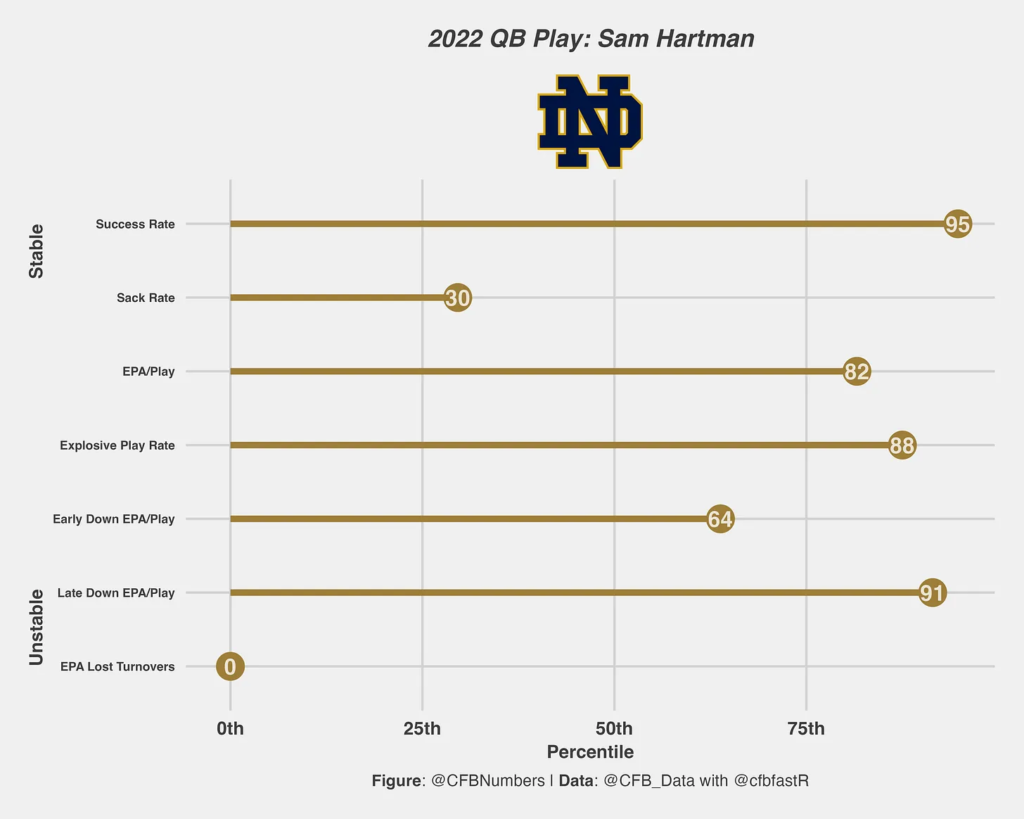
Let’s ramp up the enthusiasm for a second – whatever your favorite metric, Hartman is a stud:
- Most valuable P5 player in PFF’s wins above replacement metric looking across the past two seasons
- 2nd highest PFF graded QB across 2021 and 2022, trailing only #1 pick Bryce Young
- Led Wake Forest to 12th in EPA/pass last season
- 2nd in Total EPA gained passing last two seasons, trailing only #2 pick CJ Stroud
- 12th / 19th in FBS in QBR the past two seasons (impressive after missing games and with negative rushing value in 2022)
Those gaudy numbers accompany a unique profile in terms of how Hartman is so productive. He was a clear outlier among his peers at Wake Forest thanks to his willingness to push the ball downfield. Last season he had the deepest average depth of target (12.8 yards) by a pretty significant margin – the next highest P5 quarterbacks were Anthony Richardson and Hendon Hooker at 11.5. As a result he led the country in “air yards” despite a lower volume of attempts, and he was pretty excellent taking these shots. Hartman was 3rd in FBS on deep-ball touchdowns and 10th in deep-ball completion percentage among those with enough attempts to qualify.
Step 2: Figure out how to use Hartman
QBs passing yards per attempt vs. how much of their passing yardage comes thru the air vs. YAC. Basically the “lmao Sam Hartman throwing 💣s only” graph. Will be interesting to see him in ND’s offense in 2023 #CFB #CollegeFootball pic.twitter.com/E2OkPb8KN8
— CFBNumbers (@CFBNumbers) June 12, 2023
With Hartman’s addition, the hardest job for the Irish passing offense is complete. And while Hartman’s heat map and deep ball tendencies may be unique, he’s not a one-trick pony – his numbers on 3rd down and within a clean pocket are excellent too. The slow mesh RPOs and design of the Demon Deacons offense (including using stud receiver AT Perry) have no doubt impacted Hartman’s profile, but the raw ability enabling that system to be effective is undeniable.
Still, it’s worth pausing to wonder what Hartman’s passing tendencies in the Irish offense will look like. There are hints that Gerad Parker and Gino Guidugli will continue to do many of the things Tommy Rees planned with Hartman, including a more balanced approach to running and passing in 2023. Does Hartman continue throwing bombs? Scatter in more over the middle targets to Notre Dame’s stable of tight ends? Incorporate more screens to leverage YAC ability of players like Chris Tyree and Jayden Thomas?
Step 3: Protect Hartman (from opponents and himself)
The only red flags in Hartman’s profile are the negative plays, and whew did he pile them up last year. As you can see from the chart below, Hartman lost more EPA (expected points added) due to interceptions than any quarterback in FBS in 2022. Things particularly snowballed against Louisville, where Hartman set what I have to believe is a record for EPA lost in a quarter, with three picks (two returned for TDs) and three strip sacks in the 3rd for almost 40 points lost in EPA.
The Wake Forest offensive line also wasn’t great, but analytics tell us sacks are heavily quarterback driven too, and the Demon Deacons were 97th in sack rate (7.8% of dropbacks) in 2022. Will Hartman continue to hold onto the ball too long behind a better line in South Bend (59th in sack rate in 2022)? His 2021 sack rate (6.1%, 58th in FBS) gives some hope, but it’s a clear watch-out area, especially against stacked Ohio State and Clemson defensive lines.
The receivers will see better passes, but there’s a Mayer-sized hole + depth concerns to address

Stop if you’ve heard this before – returning receiving production is one of the most critical factors projecting offenses season to season. And purely from this statistical perspective, Notre Dame is in pretty dire straits, with 62% of last season’s receptions and receiving yards leaving South Bend.
Michael Mayer shouldered an enormous workload, seeing targets on 1/3 of his routes and still managing the highest yards per route run of any FBS tight end. Despite defenses best efforts, Mayer was still efficient and fairly explosive, logging a higher long reception rate than Lorenzo Styles, Jayden Thomas, or Braden Lenzy. His presence also likely had a positive trickle-down effect for the rest of the receivers, even if Pyne couldn’t always take advantage.
Jayden Thomas burst onto the scene with a very nice fall, leading the starting wide receivers in yards per target with solid efficiency and decent explosiveness. Thomas wasn’t targeted often but should see a much bigger workload as the leading returning receiver, and showed promise both on downfield throws as well as creating yards after the catch.
TOUCHDOWN GOLD@sam_hartman10 to Jayden Thomas 💪#GoIrish☘️ pic.twitter.com/kdBe4jlfEO
— Notre Dame Football (@NDFootball) April 22, 2023
Styles and Lenzy also depart, and their numbers from 2022 highlight the relatively disappointing years. Styles saw almost exclusively short targets and was inefficient when targeted. Lenzy fared slightly better but had one of the lowest explosive play rates and yards per route among wide receivers. How much blame belong with the receivers versus how they were utilized and targeted is up for debate – Lenzy certainly could have benefited from a better deep ball thrower. But I don’t think it’s a slight to either player to think that their production might be easier to replace in real life than statistically, especially with Hartman under center.
Deion Colzie flew under the radar last year recovering from injuries and not receiving a ton of looks from Pyne. But he was extremely effective when targeted down the stretch, with a yards per route run number on par with Mayer and high efficiency despite a workload far downfield and in many high-leverage and 3rd down situations.
Heck of a throw by Drew Pyne to get this ball into the hole over two defenders and holy moly does Deion Colzie climb the ladder. pic.twitter.com/mc64U3uuYU
— Greg Flammang (@greg2126) November 30, 2022
What, if anything, can we glean from Chris Tyree’s receiving numbers last season? I’d take them with a heavy dose of salt – you can see that running backs as a whole struggle to be efficient with low depth of targets and receiving many check downs. Still, the lack of explosiveness is a mild concern, hopefully mitigated by a strong catch percentage (a good sign for his hands).
The Irish will need a lot of production from guys not featured on this table from last fall, with Tobias Merriweather, Mitchell Evans, and Jaden Greathouse the most likely contributors. Merriweather could easily jump from only a handful of targets in 2022 to WR1 – his size and freaky athleticism make it easy to envision Hartman lobbing plenty of deep throws his direction. The tight end room lacks a clear blue-chip NFL prospect for the moment but is oozing with quality depth between Evans (the presumptive starter), Holden Staes, Kevin Baumann, and Eli Raridon.
The obvious concern, yet again, is depth. With Styles move to defense and then transfer to Ohio State plus Kaleb Smith’s medical retirement, suddenly Thomas, Merriweather, and Colzie become indispensable. Tyree’s position change is no longer an upside play, but a necessity. At least one of the freshmen (Greathouse, Rico Flores, Braylon James, Kaleb Smith the younger/healthier/still on the roster-er) will need to contribute.
The ’23 passing attack features almost all new ingredients, with Hartman propping up the floor
The ND passing attack is the most difficult unit on the team to project. Hartman is close to a sure thing, but is he slightly less effective transitioning into a new system with new weapons? Or even better than he was at Wake with improved protection and a complementary rushing attack to keep defenses honest? Can the receivers improve on last year’s performance despite the lack of experience and production?
Base projection: A top-20 passing attack that doesn’t quite have the firepower to be elite
With all the moving pieces, it feels like it’s fair to assume Hartman transition to Notre Dame with similar to slightly better production than at Wake Forest, which put them at the edge of a top-10 passing attack before adjusting for competition. The improvement in run support and offensive line likely offset the small loss of proven receiving options (underrated at Wake, who has done a nice job of WR recruiting and development in recent years) Jamie Uyeyama’s recent (and always a must-read) 6 Thoughts touched on Hartman’s relatively low rate of turnover-worthy plays, and the adverse conditions caused by Wake’s defense that also may have contributed to some of his risk-taking.
It’s tempting to project even greater things, but ultimately it feels a couple of proven receiving options away. The ceiling with young talent is high, but the floor is also fairly low – it’s easy to see depth, consistency issues, or the lack of a go-to guy limiting the WR unit. The breakouts of Merriweather or Thomas now feel like “must-haves” as opposed to luxuries. And without going into too much offseason depth, there’s less certainty from a scheme and play-calling standpoint with Parker than there was with Rees or many of the other OC candidates. It should be one of the better passing attacks in recent memory, but it’s hard to see it stacking up among the nation’s best with so many questions about the pass-catching, offensive scheme, and personnel.
Low projection: Pieces take a long time to mesh, and/or injuries tank shallow position groups
In a worst-case scenario, Hartman plays only half the games (or less) and for a second straight season a backup has to salvage what’s possible after the ceiling of the passing game drops significantly. Parker and Guidugli have a difficult time establishing the right balance of rushing and passing and a clear identity for the offense as a whole. The wide receivers are fine but less threatening than anticipated, with no clear game-breaker and fatigue + injuries setting in over the course of the season. Quarterback sacks and turnovers are an issue, and the interior of the line struggles to hold up for long against quality interior DLs.
High projection: A top-10 passing game (on a per-play basis)
The balance of the offensive and lack of receiving depth make it unlikely that Hartman will air it out at the volume needed to compete for the prime end of season awards, unless he’s spectacular in the three biggest games on the schedule. But there’s little doubt in a best-case scenario that the Irish can have a top-10 passing offense in EPA, passer ratings, or yards per attempt. Hartman is that good, already, and could easily clean up the mistakes that plagued him in Winston Salem with a superior supporting cast.
The other key enablers for this to transform into an elite unit:
- Tobias Merriweather turns into a bona-fide WR1 and NFL draft prospect, piling up a Will Fuller-like sophomore breakout.
- Jayden Thomas and Deion Colzie round out a balanced starting receiver group that’s efficient converting third downs and land their own share of back-shoulder and jump-ball throws from Hartman. Jaden Greathouse and Chris Tyree pack a potent one-two punch in their snaps from the slot and spelling the starters.
- The tight ends just keep coming in waves with Mitchell Evans showing downfield ability and Staes and Raridon contributing in key spots. A unit that feels light on pass-catchers suddenly has a lot of potential targets.
- The offensive line is exceptional in pass-coverage – as expected from the tackles, but critically up the middle too. Hartman has a ton of time to find open targets and improvise downfield, and smartly balances risks with turnover-worthy plays.
- Parker + Guidugli is a terrific duo, leveraging their combined experiences to build a balanced offensive attack that’s efficient and explosive enough to hang with Ohio State and USC
Ok, that was a little indulgent, but Hartman has the chops to take the passing attack to great places by minimizing negative plays and turnovers and getting some help with some receiver breakouts. That feels very possible – Merriweather is such a physically gifted receiver, Thomas flashed last season and seems like a contender for captain duties, and it’s a decent bet that one of Colzie/Greathouse/Tyree/James becomes a steady contributor, if not more. If anything I’m skeptical about the offensive braintrust being able to mesh and gel early enough.

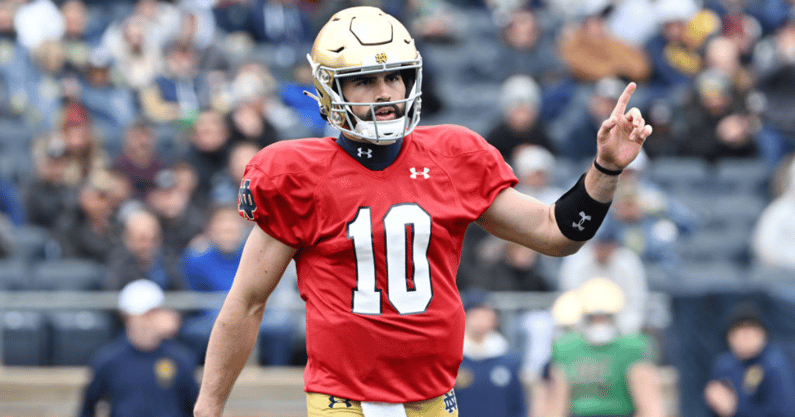

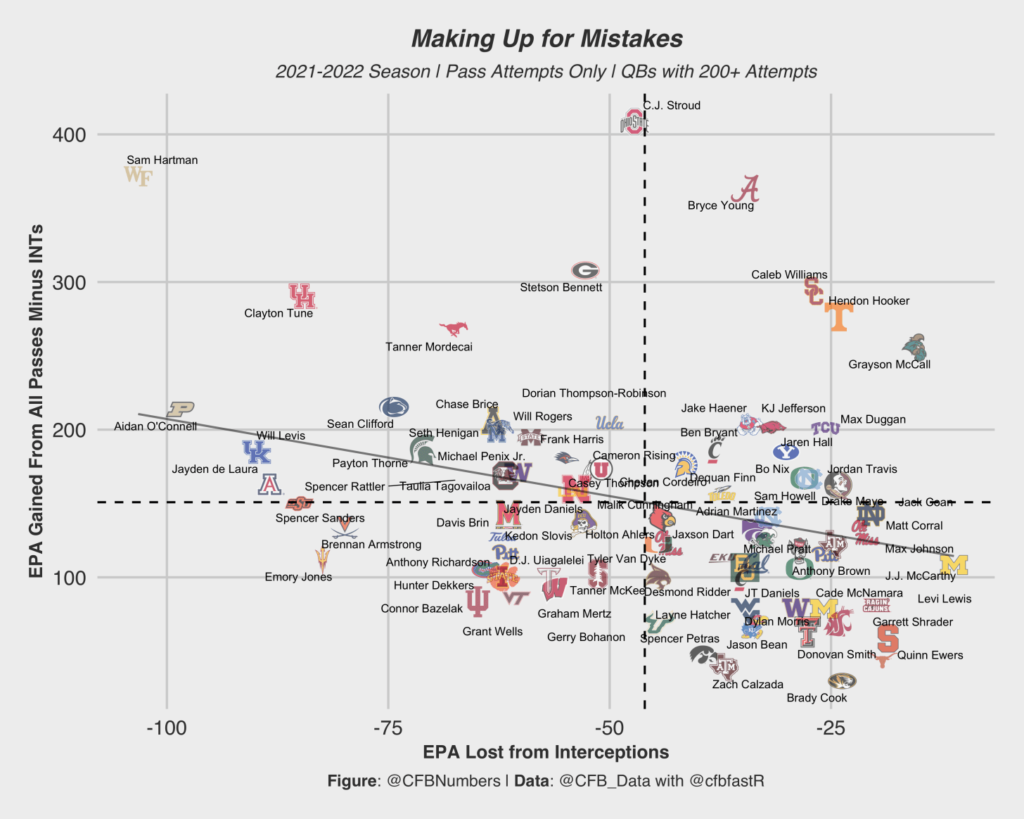
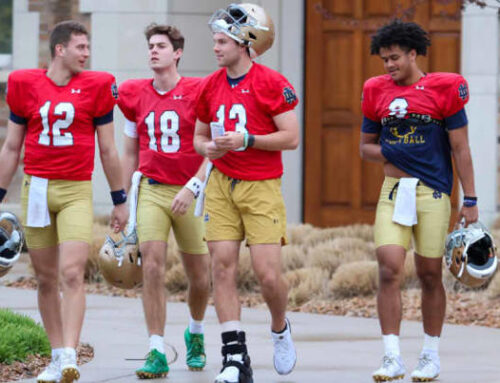
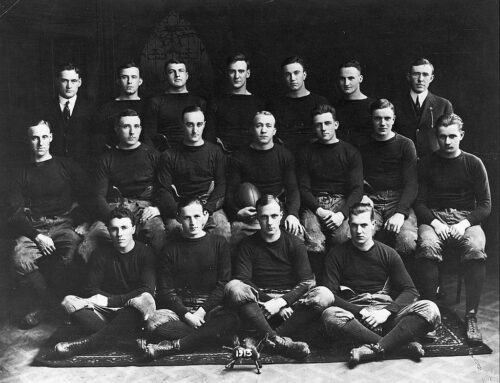

A few things that stand out from these charts:
I wonder if they were trying to get Styles easy catches when he starting dropping the ball and so that kept him closer to the line of scrimmage.
I think we’ll be surprised how much Hartman, being a good QB, improves things for everyone. Assuming health with the right people, I’m looking forward to those bombs to our big and speedy WRs. And I think that, again, makes things easier for everyone else – including someone like Colzie.
It should go both ways too – Hartman should benefit from defenses that have to respect the run, not having to throw deep so often when defenses know it’s coming, etc.
Definitely agree with your last paragraph. It may not be every play of every game, but I think this season is going to be eye-opening for ND fans as to what a complete offense looks like.
I definitely think the coaches tried to create some “easy” catches for Styles. But I don’t think those are actually “easy” for people with the yips. You have to think about turning and running immediately. Would have been better to just hit him on a few deeper plays or anything where his only worry is catching it.
Wait are you allowed to have a passing game?
Well, you can, but wouldn’t you rather have more manly and traditional fullbacks?
Like 5 Wide Fullbacks maybe?
Taking all those receivers really cuts into scholarships for kickers
And long snappers
They should keep Milk on scholarship until the NCAA notices and puts an end to it. Not convinced that isn’t what is going down at the moment anyways.
A few personal observations and stats from last year to add;
I anticipated improvements in all of these areas with subsequent improvements in the passing game.
Should be “RB protection”
I’ve mentioned this before but I get the impression that a lot of ND fans are just against transfers altogether and think that Pyne/Buchner were somehow unfairly chased off.
I could see this offense looking somewhat like 2006 — statistically, a good (i.e. top 20) unit overall, but with some long dry spells when Hartman and the receivers get out of sync. I also expect that, like 2006, we’re going to need heroics from Hartman to escape with a win on more than one occasion. I think/hope the OL will be able to handle aggressive defenses better than the 2006 OL did.
Maybe it’s thinking about Jack Coan? Played very solid QB but wasn’t transformational for the program.
Walter Football had Coan as the 8th best QB in 2022. Hartman is rated #12 now, which seems a little low, but when I look at the list, I don’t see him clearly better than the 5-8th ranked crowd.
Other point is that he’s a 6th year guy. Why isn’t he in the NFL yet? Kind of like in baseball what they call the AAAA player, the guy in his late 20s who has finally figured out how to mash AAA pitching but flounders when he gets up the majors because he’s high floor/low ceiling.
Wildly optimistic about Coan (or the QB class that year was totally awful). He didn’t even play the year before he transferred, and was only OK when he did play prior that. You might be right about Coan creating some apathy towards a veteran transfer, but Hartman is a way, way, way more accomplished player.
To your last point, sure it would be more buzz to get a Caleb Williams/Burrow/Fields type of transfer with NFL upside (need to take undergrads to get them though) but I don’t see why Hartman would have less buzz just because you correctly point out he’s not much of a pro prospect. I couldn’t care less about that aspect, if anything his experience gives him what we know will be a higher floor of what he’s proven (lots of yards, TDs and, yes, turnovers).
Pretty much agree, was just making some conversation for us to debate. I’m pretty pumped about Hartman.
I don’t know why I love to watch the pass blocking montage of Kyren Williams in the Clemson win with Book. The pass blocking is great, but one thing you notice about Book is his pocket presence as a multi-year starter. Many times Kyren will redirect a pass rusher enough that Book does a little slide to the side while keeping his eyes downfield and then making the throw.
You can see the same thing with Hartman, like in the spring game I think it was Salerno crossing in the end zone, you can see Hartman spotting him coming open but then he hesitates another 0.5 second to let him clear the second level and make a much easier catch. That’s the kind of thing I’m pumped for.
Well, Hartman was playing in a very un-NFL offense at Wake Forest, which is (allegedly) part of why he wanted to transfer to ND. Why he’s not in the NFL yet is a fair question, but I’m happy he’s here!
Yeah I fully expect him to have the best season as a QB for ND since Clausen. I could not be more excited about him. And, hopefully, he puts up really good numbers and looks like a draft pick and we get next year’s Sam Hartman too (because we’re gonna need it!).
Walter Football is good at coverage immediately around the draft for the highest prospects (basically 1st rounders) but beyond that, they’re awful
*whispers*
Jack Coan actually had the best passing season for an ND QB since 2009 Jimmy Clausen and his performance against a top-5 Ok State defense was better than anything Book or Kizer ever did against similar competition.
*retreats into bush Homer Simpson-style*
Anybody who thinks Pyne was unfairly chased off is… wrong.
Years of not being excited about QB play and not knowing what to do?
Also it can’t help the fanbase to get excited when Hartman wasn’t even officially QB1, even though everyone could understand the dog and pony show aspects of the reasoning behind that. But with the reports of Hartman not looking great early in spring and not even named the starter, I can understand the somewhat tepid reaction.
Mix in:
-defensive head coach that is proud to be conservative with run game/ball control (i.e. better not have the same game plan vs. Ohio State this year as last. Shouldn’t design a game to “be close and see what happens”, have to be willing to trade punches with the big dogs)
-Unexciting OC with lack of playcalling bona fides
-Questions about what the scheme/identity of the post-Rees offense even is
-Mayer gone
-Complete lack proven receiving weapons
And I guess it’s natural to wait and see what happens. Spring game opened some eyes, and should have, Hartman can make some wonderful throws out there. I don’t think it will take long for the hype train to get rolling.
Stuckey getting positive press is the only thing interrupting Venables-Sanders or Northwestern drama coverage over at Football Scoop. If the receivers are anywhere past just being “good” the ceiling for the offense this year is immense.